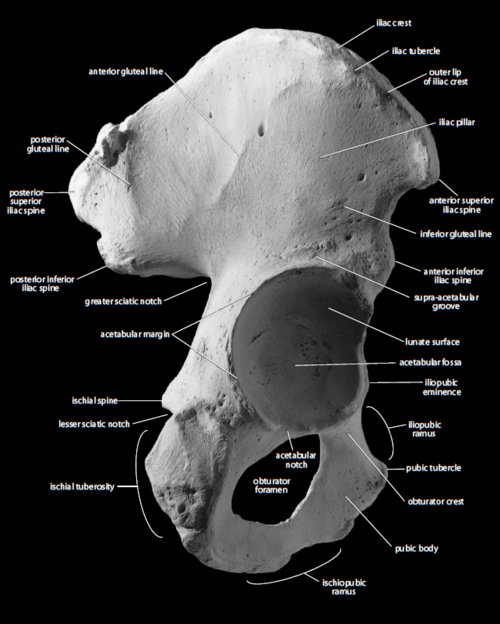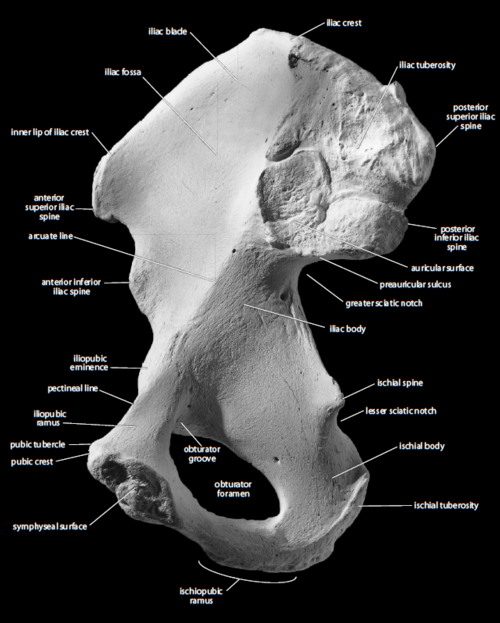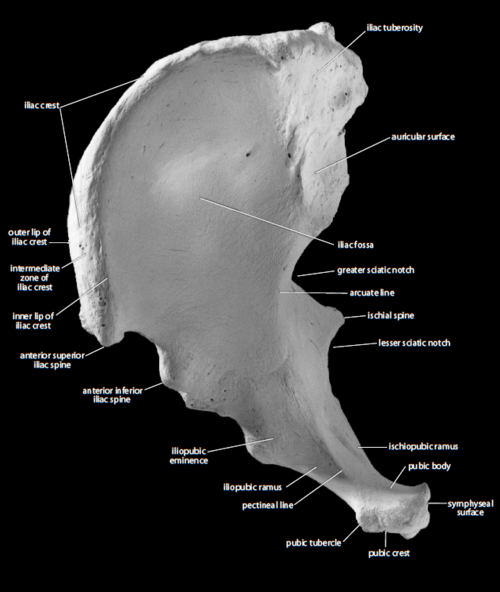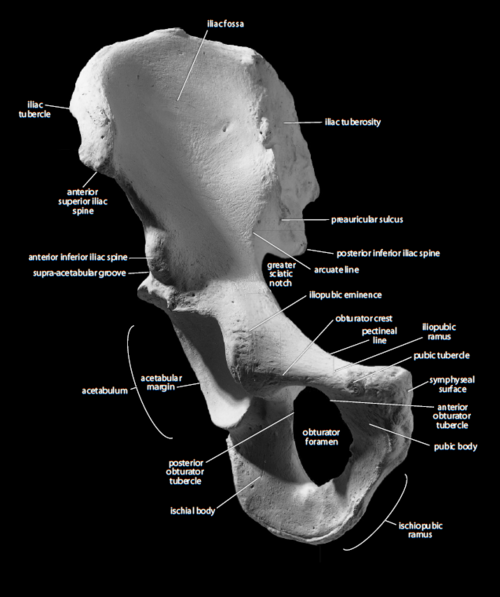The Ilium, Ischium, and Pubis (Os ilii, Os ischii, Os pubis; Os coxae, Os innominatum or the Innominates)
Right Os coxae - Lateral, Medial, Superior, and Anterior aspects
Human Osteology - 3rd EditionThe ossa coxae form the large majority of the pelvis, possessing with it the highest of the vaunted sexing power in the human skeleton. There is a great deal of sexual dimorphism which allows for that, and there are certain portions which allow for aging. Of course, there are multiple methods for determining sex and age, and the latter is on the whole less accurate, with the exception of the Rissech method (authored in part by my professor’s late husband!)
The three titular bones ultimately fuse to form the os coxae, with the ilium forming the largest portion. The photos above are of a fully fused, adult pelvis. All three bones form part of the acetabulum.
Etymology
These three bones, together and separate, have had many names conferred upon them by anatomists. They have been called the innominates or Os innominatum, because they alone don’t resemble much and cannot be named. Some have opted for a more practical nomenclature, calling them the bones of the hip in Latin.Pubis, from the genitive declension of the Latin pubes (two syllables) - yes, those pubes - from the Latin puber meaning grown up, of mature age
Ilium, directly from the Latin meaning lower abdomen, in turn deriving from the Latin ile meaning flank
Ischium, from the Latin borrowing of the Ancient Greek iskhion meaning hip joint
Coxae, from the Latin meaning hip, hipbone or thigh
In-, from the Latin (and perhaps all the way back to Proto-Indoeuropean) meaning not; *side note* I think it’s an allomorph of the Greek a-, an- which means no, not, without and there are plenty of allomorphs in the English language
-nominatum, from the Latin nominatus, which through various declensions meaning name
Articulating Bones
The iliac alae articulate (in a pincer-like fashion) with the sacrum. The acetabula articulate with both femoral heads.Features
There are soooo many and when you have an adult pelvis, it can be difficult to mentally separate the bones and its individual features. The ilium is the wing-like portion of the pelvis and lies above the acetabulum or hip socket. The ischium is the angular, blunt posterior projection that you sit on. The pubis forms the front of the bone and both pubes articulate to form the pubic symphysis.The acetabulum is where these three bones meet. It faces laterally and forms the socket to which the femoral head articulates. There are two parts of the acetabulum: the acetabular fossa and the lunate surface. The acetabular fossa or notch serves as a ligament attachment site. The lunate surface is what actually articulates with the femoral head and is a smooth, crescent-like surface that surrounds the acetabular fossa.
The obturator foramen is the gaping hole in the os coxae surrounded by the pubis and ischium. The obturator groove/sulcus is by the iliopubic ramus, more visible on the posterior than anterior aspect, and is where vessels and nerves pass along.
The Ilium
- Iliac pillar/acetabulo-cristal buttress - above the acetabulum is a vertical thickening of bone; palpable but not very visible
- Iliac/cristal tubercle - at the top of the iliac pillar is the iliac or cristal tubercle, which is a small, lateral projection
- Iliac crest - this is the superior-most border of the os coxae, the rough ridge at the top of the pelvis
- Gluteal Lines - there are three gluteal lines - anterior, posterior, and inferior - and in my experience, it’s extremely difficult to spot them, as most of the time, the area where they should be is smooth as a polished table; both serve as muscle attachment sites for the gluteal muscles
- Iliac spines - there are four iliac spines per os coxae, two in the front and two in the back; these are the anterior superior and inferior, and the posterior superior and inferior iliac spines; you can palpate the two anterior spines; these all serve as muscle and ligament attachment sites
- Greater sciatic notch - this is a wide notch (width will vary) below the rough patch of bone which contains the auricular surface and associated rough features; cortical bone is thickest here
- Auricular surface - this is what articulates with the sacrum
- Iliac tuberosity - this is a rough surface behind the auricular surface, although why it’s named a tuberosity is beyond me; serves as a ligament attachment site
- Preauricular sulcus - this is a groove on the auricular surface found typically inferiorly and will not always be present
- Iliac fossa - the broad, medial surface of the ilium which caves in slightly
- Arcuate line - this line is an “elevation” coming from the pubis to the top of the auricular surface
The IschiumLesser sciatic notch - like its namesake, it is a smaller version of the greater sciatic notch, located inferior to it
- Ischial spine - serves as a ligament attachment and is below the greater sciatic notch
- Ischial tuberosity - this is a fairly massive projection and is basically the body of the ischium; it anchors very large muscles and is the bone you sit on
The Pubis
- Pubic symphysis - where the two pubes touch and it’s also right above your genitals; this can be used for sexing and (very) rough aging
- Iliopubic/iliopectilineal eminence - this is where the ilium and pubis join
- Iliopubic/superior pubic ramus - the pubis and ilium join here on the acetabulum
- Ischiopubic/inferior pubic ramus - this is where the pubis joins the ischium
Siding
Siding these intact are easy-peasy…fragments can be very difficult and I believe one of the most difficult fragments I have ever encountered came from an os coxae. Ew.White and Folkens say that iliac fragments might be mistaken for cranial ones, but cranial bones tend to be very thin, except for a few such as the temporal bone and parts of the occipital. Some may be mistaken for scapular fragments, but scapulae are thinner.It is very easy to orient an intact os coxae. The acetabulum is inferior and lateral, the iliac crest is superior and the obturator foramen is anterior by the pubis.As for fragments, it will depend on where the fragment comes from due to the highly irregular shape of each bone.White and Folkens groups fragments into six main categories:
- Pubic regions - the pubis is smoother on the dorsal surface than the ventral surface and is convex in nature; the superior ramus of bone should be thicker than the angled, inferior ramus; the symphysis faces the midline and should be very rough
- Ischial regions - the thicker ramus faces the acetabulum and the tuberosity is back and lateral
- Iliac blades - the iliac pillar is lateral and anterior; auricular surface and rougher features are posterior and face the midline
- Iliac crests - remember the iliac tubercle which is toward the anterior superior iliac spine and juts out laterally; the crest thins out as it tends toward the back and is more concave anteriorly than posteriorly
- Isolated acetabula - the lunate surface forms a “c”, of which the inferior end is broader and blunter than the superior end; the acetabular notch is also inferior; the ischial ramus is posterior to the acetabulum whereas the superior pubic ramus is anterior to it; as always, the ilium is superior to it
- Isolated auricular surfaces - the auricular surface itself is anteriorly positioned and the other roughened features are posterior; the sciatic notches are posterior
I once received a fragment that had nothing but an arcuate line. If I remember correctly, it was either an iliopubic or ischiopubic fragment and I got it wrong. Very wrong. I don’t really remember other pelvic fragments, but it was atypical.Facts
Neanderthals had anteriorly projecting pubes. Once upon a time, I found out that Milford Wolpoff said this half in-passing: Neanderthals have really long pubes. Not sure if he meant it as a joke or has always pronounced it that way…
| 11 years ago +8 |




